A Brief History
Discover the ancient origins and fascinating history of tea!
This section contains an extended examination of the social role tea has played in British society, and subsequent debates.
 A cup of tea is a vital part of everyday life for the majority of people in modern Britain - in fact tea is so integral to our routine, that it is difficult to imagine life without it! But it was not always so; tea was once a luxury product that only the rich could afford, and at one time there was even a debate about whether it might be bad for the health. It was over the course of several hundred years that tea gained its place as our national drink, and only relatively recently that its health-giving properties have been recognised.
A cup of tea is a vital part of everyday life for the majority of people in modern Britain - in fact tea is so integral to our routine, that it is difficult to imagine life without it! But it was not always so; tea was once a luxury product that only the rich could afford, and at one time there was even a debate about whether it might be bad for the health. It was over the course of several hundred years that tea gained its place as our national drink, and only relatively recently that its health-giving properties have been recognised.
a lover of tea since her childhood in Portugal
Tea first became established in Britain because of the influence of a foreign princess, Catherine of Braganza, the queen of Charles II. A lover of tea since her childhood in Portugal, she brought tea-drinking to the English royal court, and set a trend for the beverage among the aristocracy of England in the seventeenth century.
The fashion soon spread beyond these elite circles to the middle classes, and it became a popular drink at the London coffee houses where wealthy men met to do business and discuss the events of the day. But the tea that was being drunk in those seventeenth century coffee houses would probably be considered undrinkable now. Between 1660 and 1689, tea sold in coffee houses was taxed in liquid form. The whole of the day's tea would be brewed in the morning, taxed by a visiting excise officer, and then kept in barrels and reheated as necessary throughout the rest of the day. So a visitor to the coffee house in the late afternoon would be drinking tea that had been made hours before in the early morning! The quality of the drink improved after 1689, when the system of taxation was altered so that tea was taxed by the leaf rather than by the liquid.
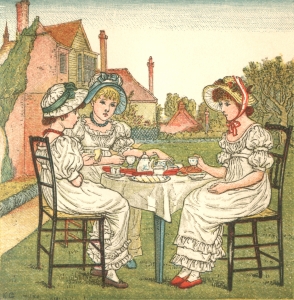 Some coffee houses also sold tea in loose leaf form so that it could be brewed at home. This meant that it could be enjoyed by women, who did not frequent coffee houses. Since it was relatively expensive, tea-drinking in the home must have been largely confined to wealthier households, where women would gather for tea parties.
Some coffee houses also sold tea in loose leaf form so that it could be brewed at home. This meant that it could be enjoyed by women, who did not frequent coffee houses. Since it was relatively expensive, tea-drinking in the home must have been largely confined to wealthier households, where women would gather for tea parties.
Such a party would be a genteel social occasion, using delicate china pots and cups, silver tea kettles and elegantly carved tea jars and tea tables. All the equipment would be set up by the servants, and then the tea would be brewed by the hostess (aided by a servant on hand to bring hot water) and served by her to her guests in dainty cups. Both green and black teas were popular, and sugar was frequently added (though like tea, this was an expensive import); in the seventeenth century though, it was still unusual for milk to be added to the beverage. We can imagine then that while seventeenth century men were at the coffee houses drinking tea and exchanging gossip, their wives gathered at one another's homes to do exactly the same thing - just in a more refined atmosphere!
Fluctuations in the level of tax meant fluctuations in the price of tea, and during the seventeenth century frequent tea-drinking was beyond the means of the majority of British people.But despite its high price, the British took to tea drinking with enormous enthusiasm. In the eighteenth century there was a clear gap between the large number of people who wanted to enjoy tea regularly, and the relatively small number of people who could actually afford to do so. And into this gap stepped the smugglers. If tea was smuggled in, no duty was paid on it, so it could be sold much more cheaply. Highly-organised smuggling networks were developed to cater for the popular demand for tea. Though these gangs of smugglers could frequently be ruthless in their practises, such was the popularity of tea-drinking that many people were prepared to turn a blind eye. By the later eighteenth century, it is estimated that more tea was smuggled into Britain than was brought in legally. This had two important effects for tea drinking: firstly, because it made tea affordable, it made the beverage ever more popular among all sections of society, and ever more integral to everyday life. Secondly, because the smugglers were based in coastal areas and their networks spread across the countryside, it drove the enthusiasm for tea drinking out of the larger towns and cities and into rural areas.
slashed the duty on tea, making it much more affordable
By 1785 the government (under pressure from legal tea merchants whose profits were being seriously undermined by all the smuggling) slashed the duty on tea, making it much more affordable. This wiped out the illegal smuggling trade virtually overnight. It still was not cheap, and for many years tea was often adulterated with leaves from other plants or with leaves that had already been brewed, which made it more affordable but much less pleasant! There was a great deal of concern about adulteration - some unscrupulous individuals added poisonous chemicals to make green 'tea' the right colour - and these concerns led to an increase in popularity in black tea, and a parallel increase in the addition of milk to tea. Such was the popularity of the beverage that many employers provided free tea to their employees (just like tea breaks in offices and factories today!) while household servants were often provided with a tea allowance. Although it is not documented, these employers were surely well aware that a cup of tea was just the thing to refresh their employees and perk them up.
But not everyone agreed that tea was an appropriate drink for the working classes. Indeed, from the early eighteenth century well into the nineteenth century a debate raged among middle and upper-class commentators about the benefits or otherwise of tea drinking - and particularly about whether the lower classes should be allowed to drink tea at all. This was partly based upon a consideration of whether tea might be injurious to health (it was a long time before the benefits of tea to health would be scientifically proven) but also partly based upon snobbery and a belief that the poor existed essentially to serve the needs of the rich.
its particular targets were tea, coffee and hot chocolate
In 1706 a book by a doctor from Montpelier, France, was translated into English. Its title: Wholesome Advice against the Abuse of Hot Liquors'. Its particular targets were tea, coffee and hot chocolate. In the late seventeenth century, great medicinal claims had been made for hot drinks, including tea, and this book was a response to them, arguing that though while moderate consumption could be beneficial, an excess of hot drinks caused the blood and insides to heat up and that 'Excess of Heat is the most Common Cause of Sickness and Death'. Indeed, noted the doctor, 'The name of Phlegeton, one of the rivers of Hell, coming from a word that signifies to Burn, denotes, That the Abuse of Hot Liquors contributes very much to People the Kingdom of Death'. Medical science at the time was so basic that the 'evidence' presented in the book was based largely upon vague anatomical knowledge and references to Bible stories and classical Greek and Roman texts. It is noted, for example, that Methuselah, the Old Testament figure who lived almost a thousand years, never drank hot liquors.
This book though counselled moderation rather than abstinence (and noted indeed that an excess of cold is equally as damaging as an excess of heat).  But a few decades later in 1748 John Wesley, the great preacher and founder of the Methodist movement, was arguing for complete abstinence from tea, on the grounds that it gave rise to 'numberless disorders, particularly those of a nervous kind'. He cited the example of himself, claiming that tea drinking had caused in him a 'Paralytick disorder', which had cleared up since he began to abstain from the beverage. Wesley urged that the money previously spent by an individual on tea should instead be given to the poor, and as an alternative hot infusions could be made from English herbs including sage or mint. His argument was certainly thorough (although medically entirely incorrect), and he even touched on how one ought to deal with the awkward situation of having to refuse an offered cup of tea. The tract is shot through with the emphasis on the religious importance of self-denial that was a central tenet of early Methodism, but in fact at later in his life Wesley went back to tea drinking.
But a few decades later in 1748 John Wesley, the great preacher and founder of the Methodist movement, was arguing for complete abstinence from tea, on the grounds that it gave rise to 'numberless disorders, particularly those of a nervous kind'. He cited the example of himself, claiming that tea drinking had caused in him a 'Paralytick disorder', which had cleared up since he began to abstain from the beverage. Wesley urged that the money previously spent by an individual on tea should instead be given to the poor, and as an alternative hot infusions could be made from English herbs including sage or mint. His argument was certainly thorough (although medically entirely incorrect), and he even touched on how one ought to deal with the awkward situation of having to refuse an offered cup of tea. The tract is shot through with the emphasis on the religious importance of self-denial that was a central tenet of early Methodism, but in fact at later in his life Wesley went back to tea drinking.
published a pamphlet claiming that tea was virtually a cure-all
In the following years the debate about the health-giving properties of tea got under way in earnest. An anonymous 'Gentleman of Cambridge' published a pamphlet claiming (based on the work of a physician who had served no less a figure than the King of Denmark!) that tea was virtually a cure-all. He cited conditions as varied as scurvy, rheumatism, inflammation and poor sight, all of which he said could be cured by the daily drinking of large quantities of tea. He also noted that it was particularly beneficial to the 'fair sex' (meaning women), which was a great contrast to the doctor of Montpelier, who was very concerned that hot liquors could heat the womb and adversely affect a woman's fertility (his evidence for the adverse effect of heat included the Biblical figure Rachel, who had rather a hot temper, and had to wait many years to conceive).
In 1757 the philanthropist Jonas Hanway published an essay on the effects of tea drinking, 'considered as pernicious to health, obstructing industry and impoverishing the nation'. Published in the form of 25 letters written to two wealthy female friends, Hanway dismissed the claim that tea could cure scurvy, and claimed instead, like Wesley, that it caused 'paralytic and nervous disorders'. He was particularly concerned about its effect on women: 'How many sweet creatures of your sex, languish with weak digestion, low spirits, lassitudes, melancholy, and... nervous complaints? Tell them to change their diet, and among other articles leave off drinking tea, it is more than probable the greatest part of them will be restored to health.' He also appealed to their vanity - insisting that due to women drinking tea 'there is not quite so much beauty in this land as there was'. But more than just injurious to women,Hanway believed that tea-drinking risked ruining the nation, because of its increasing prevalence among the working classes, and associated the drinking of tea with the drinking of gin. He argued that the poor could ill-afford to spend their money on tea, claiming that 'those will have tea who have not bread', and that children born to poor mothers were dying because their mothers were spending all their money on tea, and drinking this 'liquid fire' while breast-feeding. This, he claimed, had led to a decline in numbers in the workforce, which he believed was obstructing agriculture and manufacturing, and would leave the country open to attack because there would not be enough fit men for the army. Thus Hanway urged the rich to give up tea drinking, in the hope that their example would be followed by the poor, on whose labour Britain depended. Much of Hanway's essay is then based on the assumption that the injurious habits of the poor must be controlled, not for the sake of poor themselves, but because a decline in their numbers or would ultimately be damaging to the interests of the rich.
In 1758 an anonymous author entered the debate with a pamphlet entitled The Good and Bad Effects of Tea Consider'd, which very much supported Hanway's arguments. The pamphlet argued that while tea-drinking was acceptable for the middle and upper-classes, it should be prevented among 'persons of an inferior rank and mean abilities'. Although his argument started reasonably, pointing out that a cup of tea alone was an inadequate breakfast for those who had to do hard work, it soon descended into a tirade based, like Hanway's original essay, on the belief that the social habits of the poor must be controlled for the sake of the rich. He claimed that the practice of tea-drinking in the afternoon among working class women meant that they were 'neglecting their spinning knitting etc spending what their husbands are labouring hard for, their children are in rags, gnawing a brown crust, while these gossips are canvassing over the affairs of the whole town, making free with the good name and reputation of their superiors.' He believed that it also encouraged these 'artful husseys' to drink spirits and to complain about their husbands, and urged innocent people to hold out against their malign influence. Unsurprisingly, this author was set against the practice of providing servants with an allowance for tea.
But not everybody followed Hanway's argument. The eminent intellectual Dr Samuel Johnson, a devotee of tea, so disagreed with Hanway's 1757 essay that he published a hilariously satirical review of it in the Literary Magazine, a monthly journal. 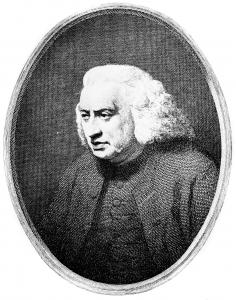 Johnson started of by admitting that Hanway should expect little justice, since Johnson himself was 'a hardened and shameless tea-drinker, who has for twenty years diluted his meals with only the infusion of this fascinating plant, whose kettle scarcely has time to cool, who with Tea amuses the evening, with Tea solaces the midnights, and with Tea welcomes the morning'. He then poured scorn on Hanway's suggestion that women are less beautiful than they once were, before considering the claim that tea-drinking has led to an increase in nervous disorders. Johnson suggested that rather than blaming tea, one ought to blame the 'general langour [that] is theeffect of general luxury, of general idleness', because those who are idle get no exercise, and are thus susceptible to nervous disorders. He argued that there is only a link with tea-drinking because tea-drinking is common among those who are already 'idle and luxurious'. Johnson was also perceptive enough to note that often tea-drinking was just an excuse for bringing people together: 'a pretence for assembling to prattle, for interrupting business' - but unlike tea's critics, who saw such gatherings as dangerous (particularly among the working classes), Johnson saw no harm in it. Thus he has much in common with many modern tea-drinkers, who delight in getting together with a cuppa for a gossip and a giggle.
Johnson started of by admitting that Hanway should expect little justice, since Johnson himself was 'a hardened and shameless tea-drinker, who has for twenty years diluted his meals with only the infusion of this fascinating plant, whose kettle scarcely has time to cool, who with Tea amuses the evening, with Tea solaces the midnights, and with Tea welcomes the morning'. He then poured scorn on Hanway's suggestion that women are less beautiful than they once were, before considering the claim that tea-drinking has led to an increase in nervous disorders. Johnson suggested that rather than blaming tea, one ought to blame the 'general langour [that] is theeffect of general luxury, of general idleness', because those who are idle get no exercise, and are thus susceptible to nervous disorders. He argued that there is only a link with tea-drinking because tea-drinking is common among those who are already 'idle and luxurious'. Johnson was also perceptive enough to note that often tea-drinking was just an excuse for bringing people together: 'a pretence for assembling to prattle, for interrupting business' - but unlike tea's critics, who saw such gatherings as dangerous (particularly among the working classes), Johnson saw no harm in it. Thus he has much in common with many modern tea-drinkers, who delight in getting together with a cuppa for a gossip and a giggle.
Jonas Hanway was as furious with Johnson's review as Johnson had been scathing about Hanway's original work. He wrote a response to Johnson's review in the Gazateer, and in turn Johnson was moved to respond to this, again in the Literary Magazine, the only occasion on which Johnson was ever moved to reply to an attacker. Hanway would have been wise not to have taken up his pen again, for Johnson's reply to him was so witty and effective that it demolished once again Hanway's arguments. Thus ended the spat between Jonas Hanway and Dr Samuel Johnson, but the arguments about tea raged for years. As late as 1826, a London tea dealer (admittedly biassed by his profession) published a book which included a defence of tea from the claim that it caused 'nervous disorders'. With some insight, he questioned the medical basis of these disorders, and suggested that they might be cured not by giving up tea, but by the sufferers taking up regular exercise, eating healthy food and getting plenty of sleep. He noted that tea 'quenches the most burning thirst, and cheers the spirits without heating the blood... I am inclined to believe that the man who could willingly forgo the pleasures of the tea-table and society around it, wants that kind of congenial spirit without which life would be a burden, and the world a dreary waste...'. In conclusion he pointed out the government provided tea to the Navy, without any concern that 'our future enemies will have to contend with bilious and nervous sailors, instead of hearts of oak, and sinews of iron'. The arguments are now over once and for all, since it has now been shown scientifically that drinking four cups of tea a day can be beneficial to health.
movement that was primarily an attempt by sections of the ruling classes to get the working classes to give up alcohol
Given the insistence of some eighteenth-century authors of a link between tea-drinking and 'dram-drinking', it is somewhat ironic then that tea-drinking was actually being used as a weapon in the armoury of the temperance movement - a movement that was primarily an attempt by sections of the ruling classes to get the working classes to give up alcohol. Virtually since historical records began, alcoholic drinks had been a central part of the diet of men, women and even children in Britain. There was some sense in this: weak alcoholic drinks could quench the drinker's thirst without the risk of contracting disease from contaminated water. But the eighteenth century saw a rise in the popularity of strong wines such as port among the upper classes, and of spirits, particularly gin, among the working classes. In the nineteenth century there was the inevitable backlash, inspired primarily by upper class fears that gin-sodden working class would be difficult to control and unable to work. Thus a movement developed in support of temperance - the drinking of alcohol only in moderation, if at all. Tea was useful to the temperance movement because it offered a refreshing, thirst-quenching alternative to alcohol that was cheap and (made of course from boiled water) safe to drink. Preachers of temperance urged people to sign a pledge to give up drinking alcohol, and millions did so (although merely signing the paper was no guarantee of a future of abstinence). Often this took place at mass meetings, and tea would be served to those who attended. The Methodist church was at the forefront of the temperance movement and often served tea at its meetings, rather ironically since its founder, John Wesley, had been so anti-tea.
During the 1830s the movement was so successful that businessmen recognised that there was a gap in the market for catering outlets that sold non-alcoholic refreshments - a temperance alternative to pubs and inns. A great many new cafes and coffee houses opened up. Though in principal similar to the coffee houses of the seventeenth century, they were different in that these new businesses catered to the needs of ordinary people, not just wealthy men. From the 1880s, tea rooms and tea shops became popular and fashionable, particularly among women, for whom they offered a most welcome and respectable environment in which to meet, chat and relax, without the need to be accompanied by a man.
Later in the nineteenth century then, going out to a tea shop became a popular pastime for women. But tea remained a beverage that was mostly drunk at home. Tea was drunk at breakfast by all social classes. Among the rich, it would typically 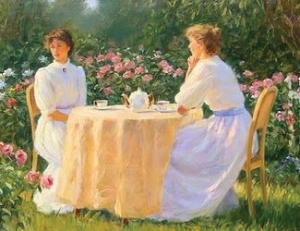 accompany a vast spread of bread or toast, cold meats and pies, eggs and fish. Of course some families favoured a lighter breakfast, and lower down the social scale this was a necessity rather than an option. Poor families usually began the day with a cup of tea, as well as bread and butter, or perhaps porridge or gruel. Tea was then drunk at regular intervals throughout the day.
accompany a vast spread of bread or toast, cold meats and pies, eggs and fish. Of course some families favoured a lighter breakfast, and lower down the social scale this was a necessity rather than an option. Poor families usually began the day with a cup of tea, as well as bread and butter, or perhaps porridge or gruel. Tea was then drunk at regular intervals throughout the day.
tea features often in the work of great author and social commentator Charles Dickens
Tea features often in the work of the great nineteenth century author and social commentator Charles Dickens. His books make it clear that tea-drinking was ubiquitous among the working classes, and through the eyes of Pip, the hero of Great Expectations, we can sense Dickens' affection for it: '...we returned into the Castle, where we found Miss Skiffins preparing tea. The responsibility of making toast was delegated to the Aged [an elderly man]... The Aged prepared such a haystack of buttered toast, that I could scarcely see him over it... while Miss Skiffins prepared such a jorum of tea, that the pig in the back premises became strongly excited... We ate the whole of the toast, and drank tea in proportion, and it was delightful to see how warm and greasy we all got after it.' On the other hand, in Oliver Twist, Dickens uses the precise tea-making ceremony of Mrs Corney, the matron of workhouse, to display her self-satisfaction, and she is wooed over a cup of tea by the tyrannical and grasping beadle, Mr Bumble, who, when she has she left the room, inspects her tea-making equipment to check that it is genuine silver.
While tea was part of the staple diet of the poor, among the rich tea-drinking was evolving into an elaborate social occasion. Afternoon teas probably had their roots in the ladies tea-parties of the seventeenth centuries, but evolved during the eighteenth century into something of a national institution. 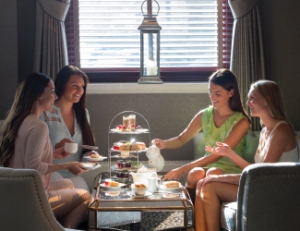 Tradition has it that afternoon tea was 'invented' by Anna Maria, the wife of the seventh Duke of Bedford, who in 1841 started drinking tea and having a bite to eat in the mid-afternoon, to tide her over during the long gap between lunch (eaten at about 1 o'clock) and dinner (eaten at around 7 o'clock). This swiftly developed into a social occasion, and soon the Duchess was inviting guests to join her for afternoon tea at 5 o'clock. It did not become instantly popular elsewhere though, partly because in fashionable circles dinner was eaten earlier, leaving less of a gap to be filled by afternoon tea. But by the 1860s the fashion for afternoon tea had become widespread. Such teas were elegant affairs, with tea drunk from the best china and small amounts of food presented perfectly on little china plates. On offer might be bread and butter, scones and cakes, and sandwiches with the crusts cut off.
Tradition has it that afternoon tea was 'invented' by Anna Maria, the wife of the seventh Duke of Bedford, who in 1841 started drinking tea and having a bite to eat in the mid-afternoon, to tide her over during the long gap between lunch (eaten at about 1 o'clock) and dinner (eaten at around 7 o'clock). This swiftly developed into a social occasion, and soon the Duchess was inviting guests to join her for afternoon tea at 5 o'clock. It did not become instantly popular elsewhere though, partly because in fashionable circles dinner was eaten earlier, leaving less of a gap to be filled by afternoon tea. But by the 1860s the fashion for afternoon tea had become widespread. Such teas were elegant affairs, with tea drunk from the best china and small amounts of food presented perfectly on little china plates. On offer might be bread and butter, scones and cakes, and sandwiches with the crusts cut off.
etiquette and good housekeeping are full of advice on how to conduct a correct afternoon tea
Contemporary manuals on etiquette and good housekeeping are full of advice on how to conduct a correct afternoon tea. The idea of needing an instruction book in order to enjoy a cup of tea and a biscuit with some friends seems rather alarming these days, but although nineteenth century afternoon teas were elaborate affairs from our point of view, in those days they were considered relatively informal occasions. Invitations were issued verbally or by note, and rather than attending for the entire duration guests were free to pop in when it suited them and likewise leave when they wanted to. The hostess would pour the tea, but it was the responsibility of the men to hand the cups round. If there were no men present, this job fell to the daughters of the hostess or other young women present (goodness know what happened if there were no men and no daughters available!). There was a fashion for women to wear tea gowns, but these were softer and less restrictive than evening gowns, and it was not always deemed necessary for women to wear gloves. Nonetheless many did, and the author of The Etiquette of Modern Society points out that a thoughtful hostess should always provide biscuits with tea, since these can be eaten more easily than sandwiches without removing one's gloves.
Some poorer households also adopted the practice of afternoon tea, and in some areas women pooled their resources and equipment in order to make such occasions affordable. But more common among the working classes was 'high tea'. During the seventeenth and early eighteenth centuries, when most people worked in agriculture, the working classes tended to have the main meal of their day at midday, with a much lighter supper late in the evening. But after the industrial revolution, more and more people were employed for long shifts in factories or mines, and hot midday meals were thus less convenient. They were also not appropriate for the increasing numbers of children who were at school during the day. The custom developed of having a high tea in the late afternoon, at the end of the working day, consisting of strong tea, and hearty, hot food. Unlike afternoon tea, high tea was the main meal of the day, rather than a stop-gap between lunch and dinner.
By the beginning of the twentieth century, there could be no doubt about the importance of tea to the British people. This was acknowledged by the government during the First World War. 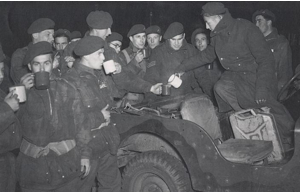 Tea was not initially rationed, but tea prices began to rise as a result of ships being sunk by German submarines, and so the government took over the importation of tea and controlled prices. During the Second World War, the government took even more drastic action to safeguard this essential morale-booster. Just two days after war broke out, it took control of all tea stocks, and ordered that the vast reserves then stored in London must be dispersed to warehouses outside the capital in case of bombing. When during 1940 enemy blockades prevented ships from getting through, the Ministry of Food introduced a ration of 2oz of tea per person per week for those over the age of five. This was not a lot, enough for two or three cups a day of rather weak tea. But there was extra tea for those in the armed forces, and on the domestic front for those in vital jobs such as firemen and steel workers. Tea was also sent in Red Cross parcels to British prisoners of war abroad.
Tea was not initially rationed, but tea prices began to rise as a result of ships being sunk by German submarines, and so the government took over the importation of tea and controlled prices. During the Second World War, the government took even more drastic action to safeguard this essential morale-booster. Just two days after war broke out, it took control of all tea stocks, and ordered that the vast reserves then stored in London must be dispersed to warehouses outside the capital in case of bombing. When during 1940 enemy blockades prevented ships from getting through, the Ministry of Food introduced a ration of 2oz of tea per person per week for those over the age of five. This was not a lot, enough for two or three cups a day of rather weak tea. But there was extra tea for those in the armed forces, and on the domestic front for those in vital jobs such as firemen and steel workers. Tea was also sent in Red Cross parcels to British prisoners of war abroad.
The end of the war in 1945 did not signal an immediate end to rationing, and tea remained rationed until October 1952. It was shortly after this that the tea bag, an American invention, began to make an impact on British tea-drinking habits. It was to revolutionise the tea industry, and today 96 per cent of all tea sold in Britain is in tea bag form.
George Orwell offered sensible advice to make the 2oz ration go as far as possible
Rationing by no means diminished the British enthusiasm for tea. In January 1946, the author and journalist George Orwell published an essay called 'A Nice Cup of Tea' in the Evening Standard newspaper, calling tea 'one of the main stays of civilisation in this country', and listing his 11 'golden rules' for tea making.He acknowledged the controversial nature of some of them - such as his insistence that the tea should be poured and then the milk added, .jpg) and that tea should always be drunk without sugar - but he also offered sensible advice to make the 2oz ration go as far as possible, such as using water that is still at the point of boiling, in order to make the strongest brew from the least tea. Orwell also used the ritual of tea-making as a device in his fiction. In his novel Keep the Aspidistra Flying, the main character, Gordon Comstock, makes tea secretly in his rented room as a means to undermine the oppressive authority of his landlady, who does not allow it. But the ritual and secret delight of Comstock's evening cup of tea also reveals something about himself: Comstock, an aspiring poet, has attempted to reject everything that he associates with bourgeois society - but he cannot reject its favourite drink.
and that tea should always be drunk without sugar - but he also offered sensible advice to make the 2oz ration go as far as possible, such as using water that is still at the point of boiling, in order to make the strongest brew from the least tea. Orwell also used the ritual of tea-making as a device in his fiction. In his novel Keep the Aspidistra Flying, the main character, Gordon Comstock, makes tea secretly in his rented room as a means to undermine the oppressive authority of his landlady, who does not allow it. But the ritual and secret delight of Comstock's evening cup of tea also reveals something about himself: Comstock, an aspiring poet, has attempted to reject everything that he associates with bourgeois society - but he cannot reject its favourite drink.
 Certainly for much of the twentieth century, methods of preparing tea were still the subject of some snobbery: in a letter to Nancy Mitford (a social commentator and great satirist of upper class behaviour), the author Evelyn Waugh mentions a mutual friend who uses the expression 'rather milk in first' to express condemnation of those lower down the social scale. Nowadays the 'milk in first or tea in first' debate is altogether more light-hearted, but nonetheless everyone has his or her preferred method of making tea. Tea has for centuries been a beverage at the very heart of social life in Britain - for millions of people today, just for Dr Johnson nearly 250 years ago, tea amuses the evenings, solaces the midnights and welcomes the mornings.
Certainly for much of the twentieth century, methods of preparing tea were still the subject of some snobbery: in a letter to Nancy Mitford (a social commentator and great satirist of upper class behaviour), the author Evelyn Waugh mentions a mutual friend who uses the expression 'rather milk in first' to express condemnation of those lower down the social scale. Nowadays the 'milk in first or tea in first' debate is altogether more light-hearted, but nonetheless everyone has his or her preferred method of making tea. Tea has for centuries been a beverage at the very heart of social life in Britain - for millions of people today, just for Dr Johnson nearly 250 years ago, tea amuses the evenings, solaces the midnights and welcomes the mornings.